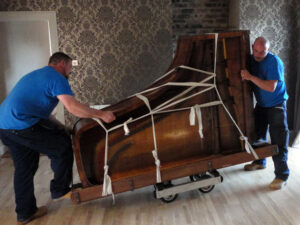If you’re planning on moving a grand piano, it’s important to get professional help. They’ll provide a safe and secure ride for your instrument while protecting it from damage. They’ll also give padding to ensure your piano can withstand unforeseen road hazards.
Pianos are incredibly heavy and difficult to transport. They require special knowledge and equipment to move safely. Visit Piano Movers in North Charleston SC for more information.

A grand piano is a large instrument with thousands of parts. It requires an experienced team of movers to move it safely and efficiently. Professional movers know how to dismantle the piano and pack it in several boxes for safe transport. They also know how to properly reassemble the piano once it arrives at its new home.
First, movers need to assess the condition of the piano. They will need to determine if it is salvageable or should be dismantled. They will also need to figure out the best way to move it. Dismantling a piano is usually much faster and more efficient than moving it intact.
The first step in dismantling a grand piano is to prop it up on something stable. This will prevent the piano from falling over as movers remove each leg. Once the piano is supported, it can be easily rolled to the truck for transportation.
Once the piano is dismantled, it is important to label each piece and keep them organized. Organizing the pieces will help prevent damage during transport and make it easier to put the piano back together. It is a good idea to use protective gloves when removing the keys and action assembly. These can be very fragile and can easily get damaged during the moving process.
After removing the key and hammers, it is important to place them on a flat surface so they don’t get lost during transport. It is also a good idea to protect the keyboard and action assembly with non-abrasive covers. This will ensure that the keys don’t scratch other surfaces.
Upright pianos are usually less complicated to move than grand pianos, but even these require a lot of planning and effort. It is crucial to measure all hallways, doors, and staircases before the move to ensure that the piano will fit. It is also important to protect floors with pads and blankets to avoid scratches or stains.
Although some attempt to move a piano independently, it is often more difficult than expected. It is very important to hire a team of professionals who have the experience and equipment needed to move a piano without damaging it or causing any injuries.
Pianos are very large and heavy and require special equipment to transport. They need to be disassembled, wrapped, and crated to protect them during the moving process. This specialized work is best left to professionals with the training and experience needed for such a task. You might save a few dollars by trying to move your piano yourself, but the risk of property damage and a back injury is much higher than the cost of hiring a professional to do it for you.
Piano movers will need several different tools to dismantle a grand piano. These include various-sized screwdrivers, moving pads to protect the instrument during transport, and stretch wrap to secure the moving pads. Additionally, they will need a pallet or skid board to place the instrument. Moving companies usually charge an hourly rate and will add extra charges for stairs and other structural obstacles. Some even have a flat rate, including labor and tool costs.
To create the piano, first, the movers will take measurements of the length of the instrument from the keys to the tail of the piano. This information will then be used to plan the transportation process carefully. A crate can be built for the piano by the movers or purchased from a company specializing in making them.
Once the piano is ready to be moved, the movers will begin to prepare the truck for transport. They will cover the truck’s floor with moving blankets to reduce the risk of scratches and other damage. They will also load the piano onto a dolly and secure it to the dolly with ratchet straps.
The movers will then transport the piano to the new location and set it up. Once it is in the right place, they will reassemble the piano and test the sound. If necessary, the movers will re-tune the piano. This is an important step because changes in humidity can affect the sound of the piano.
It is also important to note that if the piano has ivory parts, it must be removed before shipping it overseas or across the country. Ivory is banned, and some countries have similar restrictions. This process will likely require a certificate of inspection from the government agency responsible for overseeing imports and exports.
A grand piano is a large, heavy instrument that requires careful handling. It should never be moved by someone who is not an expert piano mover. Whether you are moving across the street or to another country, this is an important job that should be left to professionals who understand how to protect such an expensive and delicate instrument.
The first step is to prepare the piano for transport. This process involves removing the lid, legs, and pedals from the instrument. Each piece is then wrapped in a separate moving blanket and secured with tape. Once the pieces are covered, they are loaded onto a piano board and strapped in place. The board is a special equipment designed to hold a grand piano during transport. It can be purchased from many physical stores, including Walmart, Home Depot, and Harbor Freight. You can also find them online at Amazon, US Cargo Control, and Grainger.
Once the piano is ready to be transported, it is loaded into a truck. A driver must be present to ensure that the vehicle is equipped with a ramp that can support the piano’s weight. The driver will also need to know how to maneuver the truck and secure it in case of an accident.
After the piano is in the truck, it is loaded in a position that prevents the lid from opening during the trip. Once the truck is on its way to its final destination, the driver must check in with the piano’s owner to ensure it arrives safely.
There are many reasons to hire professional piano movers. You may be moving to a new house, or you may need to transport the instrument for a concert. Whatever the reason, you can trust the experts at services to transport your instrument safely and securely. They are experienced in moving all types of pianos, including grand pianos, and they can accommodate local, long-distance, and international moves.
Grand pianos are a beautiful and unique addition to any home. However, they require special care to keep them looking and sounding their best. This includes regular cleaning and disinfecting. This process must be done carefully to avoid damage to the finish and mechanics of the piano. This guide from PianoCraft will show you how to clean and disinfect a grand piano without damaging it.
First, you should dust the piano’s exterior to remove dirt and dust. Make sure to wipe the keys as well, as they collect dust. You can also use a vacuum cleaner with a soft brush attachment to clean the piano’s interior. Make sure not to touch any mechanical parts with the vacuum nozzle or the brush head, as this could damage them.
Next, mix a solution of four teaspoons of bleach with water. Dip a cloth or microfiber cleaning cloth in this solution, then wipe all piano surfaces. After wiping the piano, you should dry it with a clean cloth. Make sure not to use any waxes or polishes, as these can damage the piano’s finish.
Before you disinfect the keyboard, be sure to test the cleaner on a small area of the piano. This way, you can ensure the cleaner will not cause discoloration or stains on the piano’s surface. You can also use rubbing alcohol to disinfect the keyboard but not apply it directly to the keys. It would be best to use separate cloths for ebony and ivory keys, as the acid in some cleaning products can discolor them.
It would be best to maintain a stable temperature and humidity level in the room where you keep your piano. This will help to prevent the wood from warping or expanding in size. In addition, you should avoid placing your piano near a heating register in the winter or an air conditioning vent in the summer. You should also keep your piano away from direct sunlight, as this can damage the strings and other internal components.
